The Scissor - That Singularity
Saturday, January 17, 2009
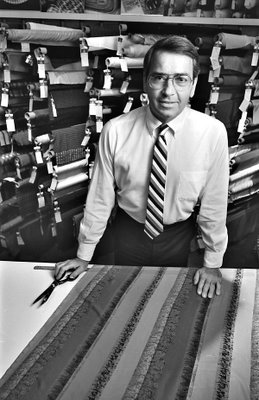
When I first met my future wife Rosemary Healey in 1967 I had no idea what Canadians were like. I knew nothing about Canada. Rosemary was blonde, she spoke English, she wore miniskirts, she seemed to be a gringa like most of the other gringas we Latinos were inexorably attracted to. I first noticed something was amiss when she told me about her grade 12 students she had brought from Canada in an exchange program. It sounded odd. "Do you mean the 12th grade?" I asked her. Then she told me of a man she said was the prime minister of Canada. His name was Pierre Trudeau. And she added, "he is sexy." I had no idea who the man was. In Mexico at the time my only connection with Canada was the pine (not a pine at all, and how was I to know it was a Douglas Fir?) we bought at Christmas time. A label said, "Importado del Canadá."
Rosemary was born in New Dublin, Ontario. I asked her if she had totem poles in her town. She told me she had never seen one in her whole life and in fact the first one she ever saw we saw together in Chapultepec Park, not far from where we lived in Mexico City. I was further confused when I asked her about Indians. Like those poles she told me she had never seen one in her life. It was from Rosemary that I first heard of a Canadian sport called skating on the Rideau Canal. She told me the best place for it was in Ottawa which was not far from the university she had attended called Laval in a place called Quebec. To top it all she pronounced that last place like the que in que será, será... It was about that time that I had read a National Geographic article on Canada that stated that Ottawa was the coldest major capital in the world and even colder than Moscow.
The big shocker was the day she told me, "Alex, you need a new pant." In hindsight I should have known better. In Spanish pants can be pantalones but we usually prefer pantalón. In fact if you go to the Real Academia Dictionary of the Spanish Language (RAE) you cannot find words like pantalones or tijeras. While you would say both in Spanish and in English to pass me the scissors, in fact that word does not exist. The instrument in Spanish only exists as a singularity. Perhaps Rosemary was speaking in some ancient but correct English were a pant was pant, nothing more and nothing less even if that pant had two cuffs.
It became patently obvious that I was in love with a strange foreigner. The Americans to the North of Mexico had a good word for such non-Americans. They called them aliens.
But things began to normalize when I noticed that Rosemary had an affinity for that troubling singularity, the scissor. The scissor would always disappear no matter where I hid it. The scissor was always important in my family as both my mother and grandmother had many pairs of them. The sight of my mother and grandmother with a scissor in hand was a comforting memory of my past that was now refreshed by Rosemary. We bought some black plastic material and a bra. I used the bra to make a pattern and with Rosemary's scissor I cut the plastic into the appropriate wedges. Soon Rosemary had skillfully sewed a bikini to die for.
In fact Rosemary was not only interested in the scissor to the point of obsession (that has not changed 40 years later) but she also broke every watch I ever gave her just like my mother broke all the watches my father and then I gave her. My mother had an immense collection of earrings. These were of the solitary and single kind. She lost an earring as fast as she bought them. Ditto Rosemary. How was it possible that Rosemary had inherited all these traits even though she was not related? To this day I cannot forget the smile that was always on my grandmother's face when she held the scissor you see here. This scissor is in my desk and Rosemary knows it is verboten for her to even touch it. We have purchased countless of that tool for years. They disappear, they become unsharpened or she loses the screw that holds the single unit together one with the other. I have bought Rosemary and English, German, Italian and even a Swedish scissor. Alas the are all gone. I keep my grandmother's Italian Monarch out of her reach in my desk centre drawer. I use it to cut my negatives or to cut my transparencies in strips.

Rosemary has other uses for the instrument. She insists on using it to prune and cut her perennials even though I bought her an expensive pair of Swiss Felco secateurs which like scissors can also be a secateur (but not in my Word Spellcheck). She manicures the grass around our rose bed and the other flower beds with the scissor.
When she comes in from the garden with her presently favourite orange scissor, Rosemary uses it to cut the French bread for cheese fondue, or cut my homemade pizza, the roasted chicken and the meat when I make shish-kabobs. Her scissor is truly home & garden.
I have received countless manicure sets from Rosemary, through the years but within months I cannot find the tweezers or the little scissor. The only one she has not ever touched is one I have for cutting my nose hair. Because Rosemary uses the little manicure scissor for other tasks when I attempt to cut thread with it after sewing on a button (Rosemary does not sew buttons) it is so unsharp it won't work. I have to scurry around the house to find a unit that will.
Rosemary is the official Christmas and birthday wrapper. At Christmas time she likes to wrap on the floor and I can hear how she snips the paper and if I spy on her she has a contented smile on her face. Rosemary and the scissor are one.
Besides my mother, my grandmother and my Rosemary the only other person I ever met who had an affinity for the instrument was Alderman (not yet our mayor) Philip Owen. He had a store under the Hudson's Bay Company parkade bridge on Seymour Street in 1986 when I photographed him for the first time. His store was a high-end establishment that sold Vogue patterns and the best cloth for the Cohens, the Belzburgs and the patrician elite of our city.
Here was a man who just like my wife, felt good with a scissor.

Miss Julie In Red & A Ghost In Black
Friday, January 16, 2009
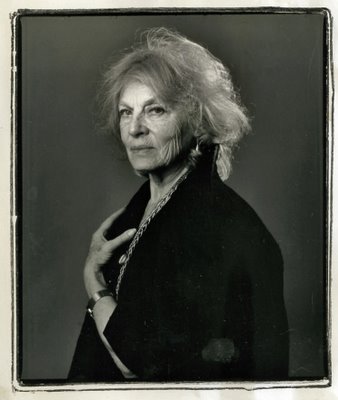 Last night I felt the presence of a ghost dressed in black. Last night at the Vancouver Playhouse Rosemary and I saw the opening performance of Stephen Sachs's adaptation of August Strindberg's play Miss Julie subtitled Freedom Summer. My knowledge of Swedish playwrights was exactly zero in August 1992 when I photographed Swedish actress Viveca Lindfors. Before I took her to my studio for her photograph I was present at an interview she gave John Lekich at the Hotel Vancouver. Lindfors kept talking, with much excitement, of her love and admiration for someone called Strindberg. I kept thinking what my gradmother would have remarked, "Un ilustre desconocido que ni en su tierra conocen." or an illustrious unknown perhaps not even known in his own land. Lindfors told Lekich of her project to appear in a play in Sweden called In Search of Strindberg. She did just before her death in 1995. In my studio Lindfors faced my camera and instructed me, "I am proud of my face. I am proud of every crease, fold and wrinkle. Make sure you capture them as they are." This I did. To break the ice (perhaps to make myself feel more comfortable in the face of this almost haughty, but sweet woman who stared at me with her striking eyes) I mentioned that I had loved her as the Queen of Spain in her 1948 film opposite Errol Flynn, The Adventures of Don Juan. She countered with, "Everybody tells me that but if you really want to know what I am most proud of it is the double bill I played off-Broadway, in 1956. I played Miss Julie in Miss Julie and Miss Y in The Stronger. Both are Strindberg plays." That evening when I went home I investigated August Strindberg. The cast of last night's production by The Playhouse Theatre Company was superb. The black chauffeur John was played by Kevin Hanchard, the black cook (her accent was so authentically impenetrable that I could not understand anything she said for the first five minutes!) was Raven Dauda and Caroline Cave was Miss Julie. It is difficult to see a play that transplants a young woman from an aristocratic family in Sweden to a small town in Mississippi on July 4, 1964 without the theatre goer of a certain age (me!) not bringing some baggage from the past. I kept comparing Hanchard's John to a fictitious (but very real to me) performance of John by Sidney Poitier. By the end of the show I concluded that Hanchard played it as well as Poitier would have. And hands down, Hanchard has a better singing voice! But it was Caroline Cave as Miss Julie (in a performance reminiscent of another one that Lee Remick never gave), in the killer red dress and the killer cleavage, that kept demanding my attention. One moment she was forcing John to kiss her shoe and the next she was pleading for him to dance with her. Last night I was the only one there with a ghost behind my shoulder, who with a smile on her face and approving of Cave's performance, whispered in my ear, "This is real Strindberg." Miss Julie - Freedom Summer continues until January 31.
Terpsichore, Beauty & My Top Ten
Thursday, January 15, 2009
 |
| Christine Chipperfield & Betty Kovacs |
Beautiful derives from the Latin bellus. The Spanish equivalent is bello (masculine) or bella (feminine). But I much prefer the other Spanish word for beautiful which is hermoso (masculine) and hermosa (feminine). This word also derives from the Latin but it is much more inclusive in its definition. The Latin word is formosus which means beautiful in form. This Spanish word hermoso is appropriate for the tone of today's blog on beauty.
In the early 80s and much of the rest of that decade I haunted the Vancouver strip clubs with my friends. Three friends in particular were Les Wiseman, John Lekich and Ian Bateson. While watching beautiful women disrobing we often discussed the topic of beauty. We threw back and forth the members of our personal lists of the most beautiful women. These lists were two fold. One was about the most beautiful women on earth and the other the most beautiful women in Vancouver. In the former list, and in particular John Lekich's list we always commented with glee that his women were mostly all dead.

We put a lot of time into our Vancouver Top 10. These days I wonder where young men (or youngish as was the case for us in the 80s) discuss this topic which has to be a universal one. Do they do it in bars? Or do they do it on line? Is it as much fun? And most of all I wonder if in our more secluded environment if anybody bothers to make Vancouver Top 10 lists. Do these young men discuss the celebrities that grace the "People" magazines?
A trend for fitness in Vancouver started in the 80s and one of the first to do it was Terpsichore. They combined an early version of aerobics with jazz dance. Many of the jazz dancers that I photographed at the CBC variety shows worked out at Terpsichore. Terpsichore had two principals. The woman on the right in the picture above is Betty Kovacs and the other, Christine Chipperfield. Chipperfield was a permanent fixture of both Les Wiseman's and my list. We thought she was beautiful and had just about the best body we have ever seen. I do remember being quite tongue-tied when this pair faced my camera.

As the 80s progressed Terpsichore closed its doors and I lost sight of Chipperfield. But in March 1995 I was dispatched by the Georgia Straight to photograph Chipperfield who was in a long and troubling lawsuit with ICBC over the debilitating effects of a spinal injury that she had suffered in a rear end collision. Some said that Chipperfield had become obsessed and the lawsuit had become all her life. I don't know for sure how her situation was resolved since I have not seen her since our photo session.
I noticed in my photographs that she had become a much more handsome woman who eschewed makeup. Her skin was perfect and her body much the same as it had been when I had first photographed her. She was obviously older. There was presence about her that I could not nail down. I could only wonder how an erstwhile perfectly fit woman would cope with physical disability.
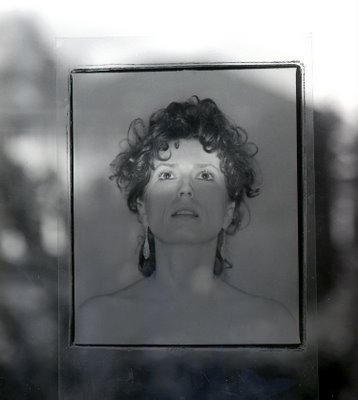
When I look at the picture with her business partner I suddenly realize that I did not give that older woman a second glance. If Les Wiseman, John Lekich and Ian Bateson and I would meet on whatever remaining strip bar we have in Vancouver I would probably now put Betty Kovacs on my list. She is truly wonderful in elegance and beauty of form. As we would say in Spanish, "¡Es hermosa!"
The Reverse Strip & A Visual Wit Of Omission
Wednesday, January 14, 2009
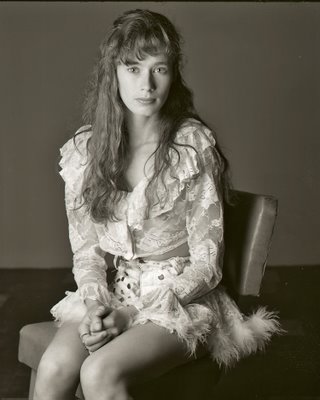
In wit of omission you say, "I could say this and make you laugh but I am not." It is a low form of wit as you really never have to come through with the goods. In this blog in the last few days I have been using its poor cousin which I call, wit of visual omission. Early on, three years ago I decided that in this blog I would not accept comments. I did not want to be at the mercy of some freak who would not let go. Another decision I made was that I would never (I may have broken this once or twice) post a nude. I would resort to that horrible sounding contemporary term, the implied nude!
If 2009 is settling into a post feminist (in the strict meaning of the word) period I would hope that I would not need much justification to show you pictures of some of the beautiful women that have faced my camera in the last 37 years. I am sure that some of my blog fans might concur.
When Shannon Keir faced my camera in the outfit you see here I had seen her without it at the Number 5. She had a beautiful body, and a face that made her seem younger than 20 even though she was in her mid 20s. When I took these pictures, perhaps some 18 years ago I was young enough that my goal was to get her down to nothing in as little time as possible. Those are the pictures that in my visual wit of omission I cannot show you. These will have to do.
If Shannon showed up in my studio now I would probably reverse the order of my session. I would have her take her clothes off immediately, take some pictures and then go for the serious clothed ones.
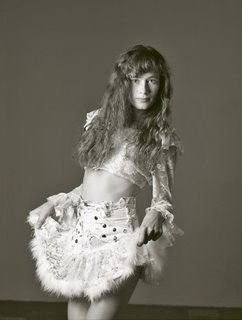
The film that I used here is a Kodak film that faced what Kodak called discontinuance. It was called Technical Pan. It was a very sharp film (the sharpest film ever made anywhere by anybody!) that had an extended range into the red spectrum to better capture the detail of a solar flare. That is what Tech Pan was designed for. It was a scientific film. But then even though we photographers are usually not scientific we like to break the rules. Any film with red sensitivity will make skin seem whiter and cleaner. It will make it glow almost like Kodak infra red film (also in discontinuance, alas!).
Looking at Shannon in Technical Pan I see a bit of the look of some of the Flemish portraits that I have so admired in galleries like the Metropolitan in New York, the National Gallery in Washington DC, the Prado in Madrid and the Louvre. Perhaps it must be the normal reaction of my 66 year-old body but I am really much more interested in these portraits than to gaze on Shannon's exquisite breasts, slim body and long legs.

It hit home today when I was reading a review of a memoir Somewhere Toward the End written by London book editor, Diana Athill (91) who writes: "A positive aspect of waning sex (Athill says she ceased to be a sexual being in her 70s) was that other things became more interesting." I must concur with Athill as I gaze on Shannon's face and see a lot more than my eyes for nudity-this-instant hid from me.
It was perhaps around 7 years ago that out of the blue I received a call from Shannon who said, "I have a white horse here in Langley. I will call you again in a few days so that you can photograph me in the barn with my horse. I am not going to be wearing anything." Shannon never called back.
Lisa - The Mystery Of The Exotic
Tuesday, January 13, 2009
My granddaughter Rebecca is 11. Since she was about 5, when she would come to visit us on Saturdays, she and Rosemary would lie in bed and read the Vancouver Sun Saturday comics. Until recently my granddaughters and their mother Hilary would have Saturday dinner with us. Sometime around 8:30 there would be a loud plunk outside the door and I would bring in a thick NY Times, Sunday edition. I would ask Rebecca what day it was and once she would say it was Saturday I would amaze her by showing her the day and date on my Sunday NY Times. This confused for a while but only recently has she caught on that the paper is put together days before Sunday.
As I think of what seems the disappearance of newspapers and particularly of their home delivery which is such a large chunk of the expense of publishing one I know I am going to miss that thud when it no longer happens. I will miss (and I only caught on to this quite recently) what I knew existed and no longer exists.
But not so Rebecca who will grow up in what will almost certainly be an era of amateur journalism. She will not miss newspapers because she was never really aware of their existence. It is almost no difference to the extinction of some Tasmanian rat we never knew about. How can we feel a loss? How can we mourn?
I am from a generation that would invariably look up when hearing the sound of an airplane's engines. And for most of my youth that was the specific sound of the propeller-driven airplane. I am also old enough in not having had a refrigerator or a telephone in my house. In fact in 1953 we were the first on the block with a Frigidaire and my friends all came to see how it worked.
My 1953 was an orderly world particularly when we studied geography. The Chinese lived in China, the Mexicans in Mexico, the Germans in Germany and so on. In those years some maps would show sleeping Mexicans under a saguaro cactus, a German in a short leather pants and the Chinese were invariably planting rice while wearing a conical hat that in Spanish (borrowed from the Tagalog) is called a salacot.
In Spain and in Latin America whatever is exotic must come from afar. And this is almost always China. India ink is tinta china and I would make my kites with bamboo and papel de china (tissue paper) stretched and glued with a mixture of flower and water. If you wanted to tell someone to go to hell you would say, "Vete a la Cochinchina." Cochinchina was the old name for Vietnam and that was as far away from Argentina or close to hell as any place could be.
Except for the odd Bolivian woman wearing a bowler hat and begging on the street or gypsies (we were afraid of them because we were told they would take us away and then sell us) who would come house to house offering to read our fortune my Buenos Aires was almost all white. In the to-this-day class society of Argentina the darker ones were called cabecitas negras or little black heads. In my early years when I was around 8 we had some live-in help. They were a black couple, Zelia and Abelardo. They were jet black. They were from a very small population of black people who were remnants of the slave population of the early 1800s. Most had moved to Perú. I had never ever seen any Chinese or Japanese except a few Chinese at the American Grammar school I attended. The Chinese children were all from the Chinese embassy. Since my grandmother worked for the Filipino Ministry I saw may Filipinos and some looked Chinese. They even wore the salakots when we went to Christmas parties and they performed Filipino folkloric dances like the tinikling and one appropriately called the Salakót.
My mother and I were once invited to have lunch at the house of the Chinese ambassador. My mother taught his children at the American school. At the table I was amazed by food I have never in my life seen before (which I didn't dare try) and marveled at the bowls with the distinctive Chinese spoons. I bragged of the experience to my friends for weeks. While in Argentina, I had heard of a mysterious Japanese gardener called Matsumoto. But I never saw him.
Even though I have lived in Vancouver since 1975 when I gaze at anybody from China I think of mystery and the exotic. Most of the beautiful rhododendrons in my garden (rhododendrons don't grow well in Argentina) are of Chinese origin and the seem most exotic to me. I am dazzled by the way their leaves retract downwards (like a cat's ears) when it gets cold.
This idea of the exotic which comes from that formerly orderly world of mine is kept alive every time I gaze on my Russian submarine clock nailed to the trunk of my Western Red Cedar. I look at it and it as alien as those terrible Russian cars one would spot on the street so many years ago. It was almost like the steel they were made from was also alien and exotic.
In 2001 when I frequented the Exposure Gallery I often saw pictures of a beautiful and undraped Oriental woman called Lisa. Just about every photographer that participated in the frequent group shows had photographed her. I was intrigued at the possibility seeing if I could do something different. I may have succeeded although I cannot show most of the results here because of my self-imposed rule of not posting nudes.
In my early shows in Vancouver I used to show at the Threshold Gallery which was owned by Mexican entrepreneur Samuel Frid. One of my first shows at his gallery was a show of domestic nudes which was part of a nude photography group show. I photographed women at home doing normal household tasks but undraped. I remember that a fierce and early Vancouver feminist movement panned the show (and in particular the other two photographers) because they had photographed the women as parts. A note was left that made me feel a tad content. The note read, "Thank you Alex, for showing us their faces."
I have rarely ever photographed the human body since without incorporating in some way that most important face. In some cases if the face is not there I try to use hands and the expressive use of hands which I believe in many ways can do almost as well.
Lisa was a mystery and a delight in my studio. In a second session I photographed her at Nora Patrich and Juan Manuel Sanchez's home and Nora set up an altar (in her living room!) behind Lisa. I have made a series of ethnic Virgin Marys and this one I called Santa Conchita de la Cochinchina. To this day when I look at these portraits I still see the exotic, the mystery of a world in which most of the countries in Africa would have borders in red. They were part of the British Empire. But there is one thing I can say about Lisa without (I hope) fearing any kind of repercussions from those feminists of yore. Lisa has the most beautiful chest I have ever seen in anyone. It is as dazzing and wondrous as that Chinese spoon.
And I wonder when Rebecca grows up if she will have a memory of the exotic and of mystery. What would it be? As for the sound of airplanes, I always look up.
El Buen Tono
Monday, January 12, 2009
In 1964 I went to Valle de Bravo, a small town in the State of Mexico. I may have gone with my University of the Americas friends Roberto Hijar and Andrew Taylor. In those days when the 35mm film camera was king of the block we would go on photo expeditions. We didn't call them safaris yet. We would walk the streets with a couple of cameras hanging from our neck and shoot whatever moved or didn't. From the negatives (two here) I note that I was using that venerable Kodak 100 ISO film, Plus-X Panchromatic. To this day I still load my Nikons FM-2 with it and in 120 size with my Mamiya.
When I took this picture of the six white hatted men I felt like I was a painter and that they were posing for my brushes. The large sign painted on the wall, El Buen Tono , which can mean the good thing, a good tone (in sound) or even the right shade of colour, made my picture seem even better. I have always treasured it even though it is not quite as sharp as it should be. The men must have moved as this is the only exposure.
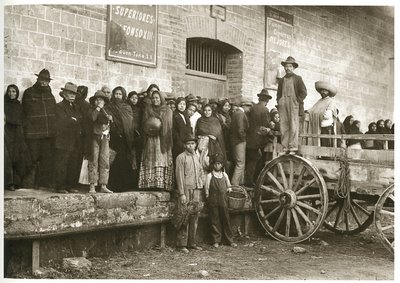
It wasn't until my Mexican friend Samuel Frid gave me, ten years ago, a book called Jefes, Héroes y Caudillos by the Mexican photographer Agustín Victor Casasola that I find out the true meaning of El Buen Tono. Casasola was the Matthew Brady of the Mexican Revolution. He, and photographers working for him, documented the revolution that brought down dictator Porfírio Díaz and ushered Mexico, through a blood bath, into the 20th century. In the book I found the photo (second from above) taken in August 1915 outside a railway station in Mexico City. On the left a sign reads Superiores Alfonso XIII El Buen Tono S.A. and on the right a sign reads Fumen Cigarros Mejores Superiores or Smoke Superior and Better cigarettes. The cigar and cigarette factory was founded by a Frenchman Ernesto Pugibet around 1884 and his company thrived even during the uncertainty of the Mexican Revolution. El Buen Tono was purchased by a larger Mexican tobacco company in 1962.
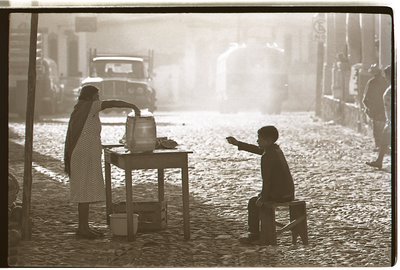
The third photograph is also one of my favourites from my era of street photography. I took it earlier in the day and I remember that the drink the woman was about to serve was agua de sandía or watered down watermelon. After taking the picture I got close to the boy and noticed that the coin in his hand was a 20 centavo piece.
El Buen Tono practiced the same shenanigans as other tobbacco companies around the world in making sure that they would always have new clients. It would seem that they also manufactured candy and chocolate cigarettes for children. Under the lovely smoking lady, it reads chocolates with fruit.
Alice Munro, Joshua Bell & By The Metro Station I Would Have Sat Down & Wept
Sunday, January 11, 2009
In the late 50s I became a science fiction fan and by the beginning of the 60s I was reading anything I could find. And this included a barrage of science fiction paperbacks featuring short story collections by individual authors or anthologies by Judith Merrill. The two science fiction short story collections that I remember best were Arthur C. Clarke's Tales From the White Hart and Ray Bradbury's Golden Apples of the Sun. Vivid in my memory from the latter is the story The Pedestrian, where a lone night walker observes the flickering shadows behind the windows of homes where people were watching their TV's in his journey through the neibourhood. A police car stops the suspicious man (by then nobody walked anywhere) and takes him away to jail. While in the police van our pedestrian is able to ascertain that there is no policeman on board (they are at the station watching TV) and that the voice of the arresting officer (and driver) is a robot.
By the end of the 60s I lost my taste for science fiction and subsequently my desire to read short stories. For me short stories did not have enough plot twists or character development. But since I was an Argentine I read everything Borges ever wrote (short stories) and most of the short story collections by Argentine Julio Cortázar. I made some other exceptions like Los Cachorros by Mario Vargas Llosa or the excellent short stories by Alejo Carpentier including his backwards Viaje a la Semilla ( Journey Back to the Source) which preceded (1958) the plot to The Curious Case of Benjamin Button. In English I made an exception to The Stories of John Cheever.
I had read so many reviews in the NY Times about Alice Munro's shorts stories that in 1990 I bought and read Friend of My Youth. Around 1980 or 1981 I had photographed her outside her old house in North Vancouver. I felt I had to give her a try. While I will read non fiction essays I still eschew shorts stories and opt for novels.
The theme of short stories became entrenched in my mind today via an email from my unlikely named first cousin Willoughby Blew who lives in Florida. He sent me this:
Subject: FW: Violinist in the Metro--- Washington DC.
A man sat at a metro station in Washington DC and started to play the violin; it was a cold January morning. He played six Bach pieces for about 45 minutes. During that time, since it was rush hour, it was calculated that thousands of people went through the station, most of them on their way to work. Three minutes went by and a middle aged man noticed there was a musician playing. He slowed his pace and stopped for a few seconds and then hurried up to meet his schedule.
A minute later, the violinist received his first dollar tip: a woman threw the money in the till and without stopping continued to walk. A few minutes later, someone leaned against the wall to listen to him, but the man looked at his watch and started to walk again. Clearly he was late for work.
The one who paid the most attention was a 3 year old boy. His mother tagged him along, hurried but the kid stopped to look at the violinist. Finally the mother pushed hard and the child continued to walk turning his head all the time. This action was repeated by several other children. All the parents, without exception, forced them to move on.
In the 45 minutes the musician played, only 6 people stopped and stayed for a while. About 20 gave him money but continued to walk their normal pace. He collected $32. When he finished playing and silence took over, no one noticed it. No one applauded, nor was there any recognition. No one knew this but the violinist was Joshua Bell, one of the best musicians in the world. He played one of the most intricate pieces ever written, with a violin worth 3.5 million dollars. Two days before his playing in the subway, Joshua Bell sold out at a theater in Boston and the seats average $100.
This is a real story. Joshua Bell playing incognito in the metro station was organized by the Washington Post as part of an social experiment about perception, taste and priorities of people. The outlines were: in a commonplace environment at an inappropriate hour: Do we perceive beauty? Do we stop to appreciate it? Do we recognize the talent in an unexpected context?
One of the possible conclusions from this experience could be: If we do not have a moment to stop and listen to one of the best musicians in the world playing the best music ever written, how many other things are we missing?
Willoughby Blew's email messaged intrigued me and delighted me. I had not heard of this incident. I immediately put the title Violinist in the Metro--- Washington DC. followed by a comma and The Washington Post. What I found was the original article. The story even includes a short video excerpt of Bell playing one of Bach's partitas for unaccompanied violin at the location in the Washington Metro.
I leave any reader here to decide which is the better story.
The short story idea came to mind because had I not been curious enough to locate the original, Willoughby Blew's email would have sufficed. We simply do not miss what we do not know exists. As we say in Spanish "Ojos que no ven, corazón que no siente."(You cannot feel in your heart what you cannot see.)
With our scatterbrained approach to music via the randomness of an iPod and multitasking, who has the time to read a novel? Would writing and publishing short story collections be a wave of our future?
Not for me.
|


























